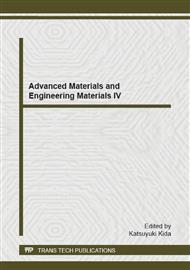[1]
Nurhaniza M., Ariffin M. K. A., Ali A., et al. Finite element analysis of composites materials for aerospace applications., IOP Conference Series: Materials Science and Engineering, Vol. 11, No. 1, (2010).
DOI: 10.1088/1757-899x/11/1/012010
Google Scholar
[2]
Dubois M., Drake Jr T. E. Evolution of industrial laser-ultrasonic systems for the inspection of composites., Nondestructive Testing and Evaluation, Vol. 26, pp.213-228, (2011).
DOI: 10.1080/10589759.2011.573552
Google Scholar
[3]
Kazys R, Mazeika L, Zukauskas E. Investigation of accurate imaging of the defects in composite materials using ultrasonic air-coupled technique., International Journal of Materials and Product Technology, Vol. 41, pp.105-116, (2011).
DOI: 10.1504/ijmpt.2011.040289
Google Scholar
[4]
Meola C., Carlomagno G. M., Squillace A., et al. Analysis of composites with infrared thermography., Macromolecular symposia, Vol. 228, No. 1, pp.273-286, August (2005).
DOI: 10.1002/masy.200551025
Google Scholar
[5]
Holmes C., Drinkwater B. W., Wilcox P. D. Post-processing of the full matrix of ultrasonic transmit-receive array data for non-destructive evaluation., NDT & E International, Vol. 38, No. 8, pp.701-711, (2005).
DOI: 10.1016/j.ndteint.2005.04.002
Google Scholar
[6]
Wilcox P. D., Holmes C, Drinkwater B. W. Advanced reflector characterization with ultrasonic phased arrays in NDE applications., IEEE Transactions on Ultrasonics Ferroelectrics and Frequency Control, Vol. 54, No. 8, pp.1541-1550, (2007).
DOI: 10.1109/tuffc.2007.424
Google Scholar
[7]
Hunter A. J., Drinkwater B. W., Wilcox P. D. The wavenumber algorithm for full-matrix imaging using an ultrasonic array., IEEE Transactions on Ultrasonics Ferroelectrics and Frequency Control, Vol. 55, No. 11, pp.2450-2462, (2008).
DOI: 10.1109/tuffc.952
Google Scholar
[8]
Moreau L., Drinkwater B. W., Wilcox P. D. Ultrasonic imaging algorithms with limited transmission cycles for rapid nondestructive evaluation,. IEEE Transactions on Ultrasonics Ferroelectrics and Frequency Control. Vol. 56, No. 9, pp.1932-1944, (2009).
DOI: 10.1109/tuffc.2009.1269
Google Scholar
[9]
Velichko A., Wilcox P. D. Reversible back-propagation imaging algorithm for post-processing of ultrasonic array data., IEEE Transactions on Ultrasonics, Ferroelectrics and Frequency Control, Vol. 56, No. 11 pp.2492-2503, (2009).
DOI: 10.1109/tuffc.2009.1336
Google Scholar


